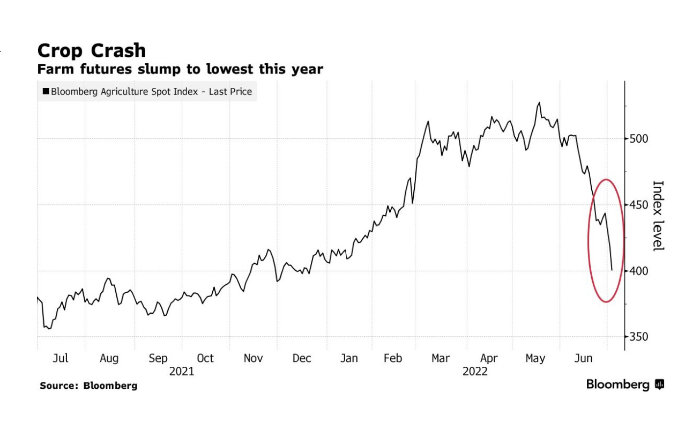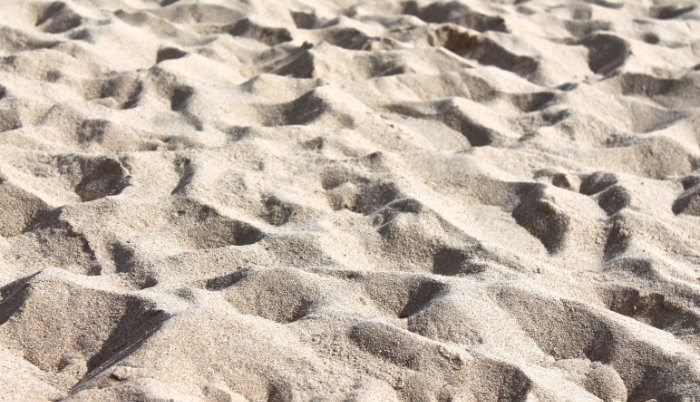In short:
- The US should again expect temperatures in the 100s for the rest of the week
- Coastal areas, such as San Francisco, will be flooded much sooner than sea-level rise models had predicted
- Palm oil, wheat, and corn prices dropped 30-40%
Economy, food security
US meat, poultry, fish, and eggs prices jumped 14% from April 2021 to April 2022, the biggest increase since 1979, according to the US Bureau of Labor Statistics. Palm oil, wheat, and corn prices dropped 30-40%, which should ease inflation worries for some. Urea prices have also been dropping lower.

Despite the war, Ukraine’s harvest is underway and they are expected to harvest at least 50 million tonnes of wheat this year, which is not bad in comparison to the record 86 million tonnes harvested in 2021. However, Ukraine doubts that they’ll be able to reach a deal that will allow for the grain stuck in the ports to be finally released. The European’s Union wheat production is slightly lower than in other years, as drought is forcing Italy and Romania to ration water. Algeria and Canada are forecast to have a good output which could ease food scarcity worries around the globe, but nearly 10% of the global population is facing hunger.
US farmers and ranchers are feeling squeezed by the high cost of diesel. With the war in Ukraine reducing grain output, some farmers are able to balance out costs by selling corn and soybean for more, but they worry that when grain prices will come down, fuel prices will not follow and farming/ranching won’t be sustainable anymore.
Climate-related food shortages are driving more Puerto Ricans to farming. If you want to have a go at growing food, here’s our beginner’s guide to survival gardening, and related posts.
Here’s a cool story about how an Arizona desert town is growing food and provides nutrition education through a community garden.
Energy
The EU voted to keep some uses of natural gas and nuclear energy in its taxonomy of sustainable sources of energy. Europe’s taxonomy is its classification system for defining “environmentally sustainable economic activities” for investors, policymakers, and companies. Gas emits nearly 59% as much carbon dioxide as coal, according to the US Energy Information Association. Nuclear power produces no emissions, although it draws criticism due to the problem of storing radioactive waste. The EU still has to reduce greenhouse gas emissions by 55% by the end of this decade. Read here about why Europe is looking to nuclear power to fuel a green future.
The Norwegian government intervened to end an oil and gas strike. Norway is Europe’s second-largest energy supplier after Russia. The strike had pushed gas prices to their highest level in four months. A sustained drop in Norway’s output could hurt efforts to replenish gas stocks ahead of the winter, as well as raise the risk of a catastrophic energy shortage. Europe is bracing for further gas supply cuts next week, while economists predict a recession. Berlin and Paris are planning bailouts.
A little fun:
European energy market update pic.twitter.com/cLlLJJFs6W
— Brian Bartholomew (@BPBartholomew) July 5, 2022
The US exported more than 5 million barrels of reserve oil to Asia and Europe last month as domestic refineries ran at full capacity.
Nuclear power gets a new push in the US. Politicians from both parties seek to prolong and even expand the use of reactors in light of the challenges associated with meeting clean energy goals and new electricity demands.
Finland launches the world’s first commercial sand battery for energy storage. Through the use of a simple heat exchanger buried in the middle of the sand, this device is capable of storing an impressive 8 megawatt-hours of energy. Whenever energy is needed, it is extracted again as heat. According to the company, the efficiency factor is up to 99%.
The prototype for UK’s first low-carbon fusion plant is going to be operational by 2040. Also, autonomous drones could soon run the UK’s electricity grid and save millions in maintenance costs.
Climate change, environment, extreme weather
The US should again expect a heat dome and temperatures in the 100s for the rest of the week. Records are expected to be set across the Great Plains and South. As a rule of thumb: keep in the shade (or somewhere with AC), and hydrate. Never leave unguarded pets or children in the car, even for small periods of time: temperature can rise very quickly in a closed vehicle, and cracking a window open does not help. You can review our heat survival guide and relevant posts here.
A summer heat wave continues across much of the Southern US, where widespread excessive heat warnings & heat advisories remain in effect and afternoon heat indices soar into the 100°'s and morning lows only manage to drop into the upper 70°'s to low 80°'s.https://t.co/VyWINDk3xP pic.twitter.com/cffRkSbAaY
— National Weather Service (@NWS) July 7, 2022
Just a month ago we had looked at how California’s Central Valley is sinking, and now San Francisco has the same issue. Actually, coastal areas in general are subsiding and they are doing so at an increased pace, according to a new study. This means that coastal areas will be flooded much sooner than sea-level rise models had predicted.
Italy declared a state of emergency in five northern regions because of drought. Italy has guaranteed water for agricultural use until July 9. At least 30% of Italy’s rice crops have already been lost. Low rainfall has also decreased hydroelectric power production by 50%. Hydroelectric power counts for 15% of the country’s energy production. To add to the problem, salty sea water has infiltrated the Po river (flowing through the main breadbasket) by 30 Km (19 miles). The US and Australia have also been recently in the news for facing increasing salinity.
A Cincinnati suburb is under state of emergency after an EF2 tornado tore through it.
86% of Texas is in drought:
An in-depth look by @NWSWGRFC at how reservoir levels in Texas are reacting to the persistent drought there. Currently, over 86% of the state is classified as being in drought, with over 16% of the state in "Exceptional Drought" — the most serious classification. https://t.co/my1NOeB3wf pic.twitter.com/c997irYVSL
— National Weather Service (@NWS) July 7, 2022
NOAA’s new supercomputers are already operating. Right now they are making sure that everything works fine, and they hope that the new and improved hurricane prediction system, the Hurricane Analysis and Forecast System, will be ready by 2023’s hurricane season. After that, they will revamp the Global Prediction System, which projects weather conditions out to 30 days or so, and the regional system, which is used to forecast severe weather. The two supercomputers have a speed of 12.1 petaflops, meaning that they can perform about 12 quadrillion calculations per second.
Bristol’s Clean Air Zone will start in November. Under the new program, petrol vehicles that do not conform to Euro 4 emission standards will be charged.
The US government is developing a solar geoengineering research plan.
Meta: How Landsat chronicled 50 years on a changing, fiery planet.
Opinion: Feeding insects to cows could make meat and dairy more sustainable. Not only it would void the need for cultivating hay and other grains for the animals’ consumption, but a study showed that feeding black soldier flies larvae it decreased the amount of methane produced.
Monkeypox
The World Health Organization will meet again on July 18 to reassess whether the monkeypox outbreak constitutes an international public health emergency. Here’s a good explainer of what PHEIC means.
Commercial labs have started monkeypox testing. They can conduct 10,000 tests a day.
Covid
BA.4 and BA.5 are becoming the dominant variants in both the US as well as Australia. The US reduced its testing capabilities and so it will be harder to monitor the trajectory of the virus. In good news, our current shots could be upgraded to target the new variants. BA.2.75 is a new variant of concern with the potential to cause a wave.
The US will allow pharmacists to prescribe Paxlovid.
The rest
Florida is 9,000 teachers short for the upcoming school year. Industry experts say nobody wants to be a teacher anymore.
The US has too many pets, and not enough vets.
The FBI and MI5 issued an unprecedented joint warning about Chinese spying, calling Beijing the “biggest long-term threat to economic security.”
More than one billion people in China have had their personal data leaked, and it’s been online for over a year.

You are reporting the comment """ by on